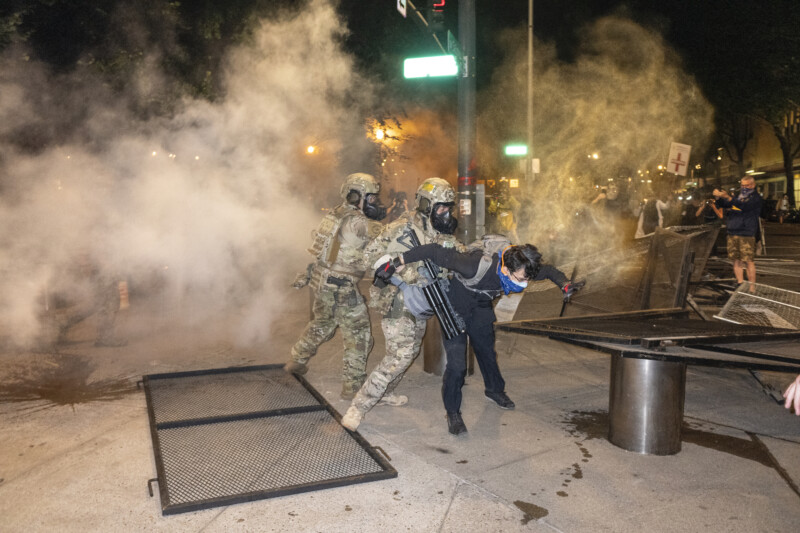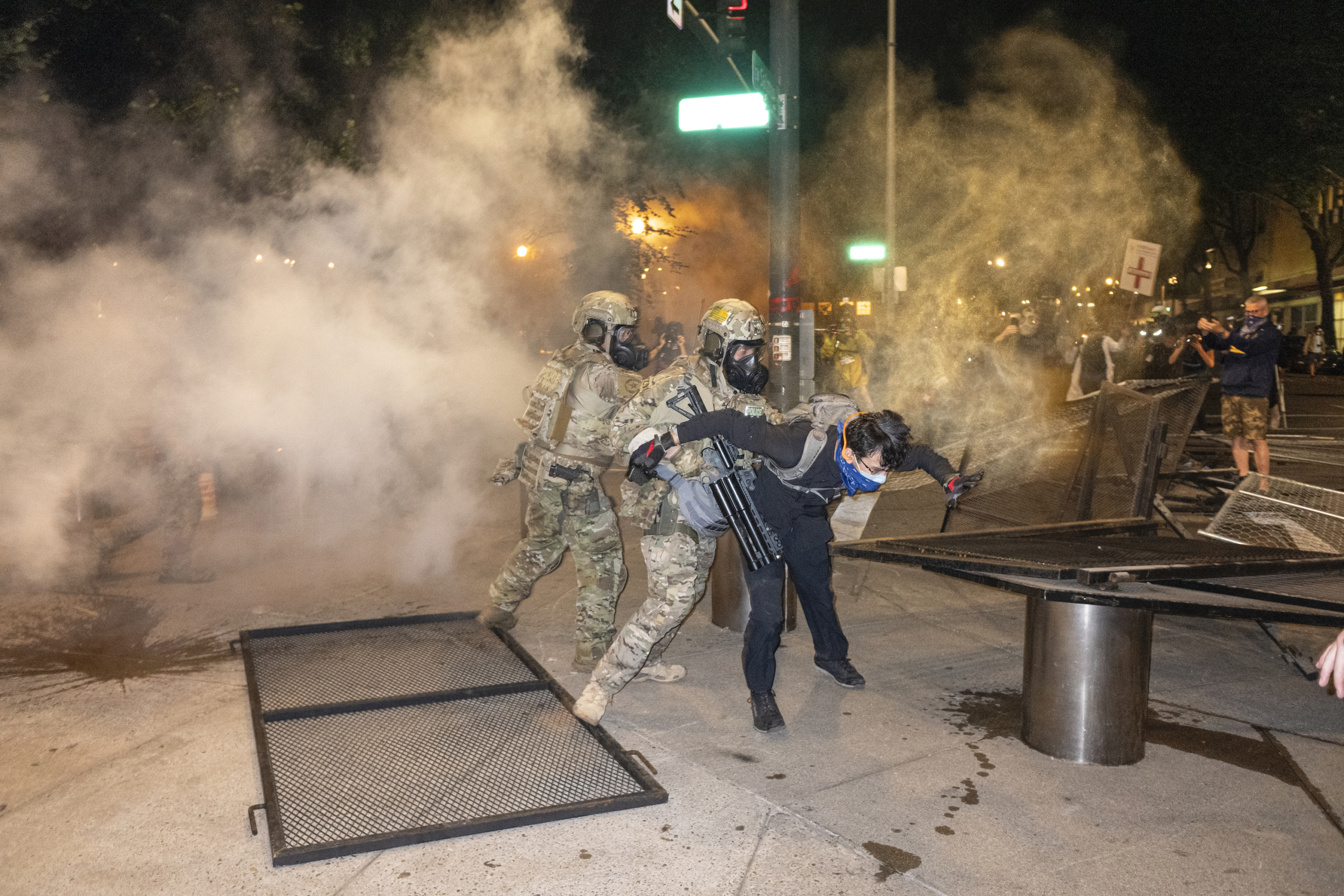Sign up for The Media Today, CJR’s daily newsletter.
Tear gas, pepper spray, rubber bullets, and flash-bang grenades—instruments of violence frequently seen in authoritarian states and war zones—are now local reporting hazards in Portland, Oregon, where protests against police brutality persist. Numerous photojournalists covering the Portland protests have reported bodily injuries from munitions and chemical weapons, as well as direct physical assaults. Increasingly, such violence directed at journalists seems inevitable—a matter of when, not if—as President Trump deploys federal agents to install his version of law and order.
“They have been shooting a lot more aggressively, a lot more flash-bangs,” Mason Trinca, a freelance photographer who has covered the protests for the New York Times, says. “It was very clear that they were not de-escalating at all.”
In the wake of the May 25 police killing of George Floyd in Minneapolis, attacks against journalists have intensified. Since Floyd’s killing, Portland’s independent Police Review Board has received seventy-six complaints against the Portland Police Bureau (PPB). In June, the American Civil Liberties Union of Oregon filed a class-action lawsuit against the PPB and the City of Portland, citing numerous examples of police attacks against the press, “to stop the Portland police from assaulting news reporters, photographers, legal observers, and other neutrals who are documenting the police’s violent response to protests over the murder of George Floyd.” Last week, a US District Court judge in Oregon granted a temporary restraining order affirming that federal agents deployed to the city must allow journalists to move freely and without harm.
To Portland’s photojournalists, the recent presence of federal law enforcement agents is more unpredictable than that of local police, with whom they might have preexisting relationships. “The feds arrived looking like they came out of Kandahar,” John Rudoff, a veteran photographer who syndicates through Sipa and the Associated Press, says. “They shoot everything that moves.” Federal police hit Rudoff with rubber bullets on two different nights, in the shoulder and leg, respectively.
In an account provided to the Committee to Protect Journalists and described to CJR, Rian Dundon, a freelancer for the Economic Hardship Reporting Project, said a federal agent threw him to the ground, causing him to fall on top of a tear-gas cannister, which exploded beneath him. As he tried to leave, with his hands up, the same agent pinned him, held a nightstick to his neck, and yanked his press tag away. While he was pinned, Dundon inhaled chemical fumes. “I don’t know what I am being gassed with,” Dundon said about chemical agents dispersed during the protests he’s covered. “I know that it hurts.”
I spend a lot of time on the pavement on my knees, and sometimes on my back, getting views from behind the barricades. The only thing I can do is be as marked up as I can and just hope I don’t get killed.
Trinca, the Times freelancer, moved to Portland from the Bay Area eight months ago. He wanted to get away from hard news and focus instead on bigger narrative stories. Because of covid-19 and the risk of infection, he initially avoided covering the protests. But when Trump deployed federal officers, national editors reached out to him, and he took the Times assignment.
As a freelancer, Trinca says, it was important for him to know that the Times would provide legal assistance if he was arrested or detained. The Times also offered hazard pay and protective gear, including a ballistic vest, helmet, and gas mask. The latter is now mandatory for those covering the front line, Trinca says, though he’s not eager to wear it. “When you put the mask on you kind of immediately disconnect as a human,” he says. “You’re almost yelling at people through your mask. You feel like you’re an astronaut, yelling into a space suit. You’re kind of photographing shapes and sounds and textures at that point.” Away from the front line, Trinca says, an N-95 “allows me to talk to and engage folks. If you don’t look human, your images won’t feel like they’re human.”
Dundon has no gas mask, and no big news organization assigning him. In the past week, he’s managed to publish three photos in The Atlantic and one in The New Yorker, for a total of $400. Despite the low pay, Dundon says he remains committed to documenting the story. Without a gas mask, he has been forced away from the front line; he’s been working the edges, taking quieter pictures, focusing on the broad base of support for the protest and asking permission of protesters, who in the past have been suspicious of journalists.

US Marshals assault a protester outside the Mark O. Hatfield federal courthouse in Portland, Oregon, July 18, 2020. Photo by Rian Dundon, for the Economic Hardship Reporting Project.
Indeed, Rudoff, the veteran photographer and one of the plaintiffs in the ACLU suit, noticed a change in protesters’ attitudes toward journalists. Since the federal police arrived, he says, “I have had a half dozen people thanking me for being there.” Rudoff has covered violent protests in other countries, and compared clashes in Portland to some he witnessed in Hong Kong last year. “The level of violence and the level of munitions that the feds are using is astonishing.” He says he makes it a point not to blend in with protesters: His helmet and flak jacket have press written on both sides, and he wears blue jeans or light-colored pants. “I spend a lot of time on the pavement on my knees, and sometimes on my back, getting views from behind the barricades,” he says. “The only thing I can do is be as marked up as I can and just hope I don’t get killed.”
Paula Bronstein, a veteran conflict photographer, has worked in Gaza, Iraq, Afghanistan, and Ukraine. Though she has lived a big portion of her life outside of the US, she started her career in Oregon in the 1990s, working for newspapers. For the past ten days she’s been freelancing—first for the Washington Post and then for the Wall Street Journal, often for ten or twelve hours per day. The Post paid her its standard rate with no hazard pay, while the Journal increased its typical daily rate, owing to threats of violence and covid-19, Bronstein says. The Journal also provided her with a gas mask, covid masks, and a neon press vest. She has a security check-in at least once a day.
Despite these precautions, Bronstein was injured last week when a federal agent body-slammed her. “I was running away from the building but only made it to the sidewalk,” she says. “I don’t think the guy even saw me. It was like a rugby body slam, and he kept on going.” Bronstein, who says she has lower-back pain and a “pretty serious black-and-blue mark above my elbow” following the incident, went back to work the next day.
On Monday, the Washington Post reported plans by the Trump administration to send more federal agents to Portland. That day, Rudoff had ended his work around 3:30am. An acquaintance and video journalist from Los Angeles had been hit in the arm with a marking round while she worked alongside him. “She had a white press helmet and a fluorescent yellow press vest,” he wrote in an email. “So it fucking goes.”
Editor’s note: Yesterday, Oregon Governor Kate Brown announced that the Trump administration “has agreed to withdraw federal officers from Portland.”
NEW AT CJR: What the lawyers who sue the press think of the press, and media law
Has America ever needed a media defender more than now? Help us by joining CJR today.



